LOST VEGAS: 5 Design Details You Didn’t Notice Go Away
Posted on: September 3, 2025, 09:31h.
Last updated on: September 16, 2025, 07:22h.
- The Las Vegas Strip is always changing in ways that many people may never notice
- Many once-popular attractions and public spaces have quietly been removed or replaced, often in the name of increasing profits
Everyone notices the major ways the Las Vegas Strip continues its never-ceasing transformation into something different — the beloved casino resorts that vanish or change brands, the open-air retail and dining districts that sprout up in every available cranny, the beloved neon signs that are all now digital screens.
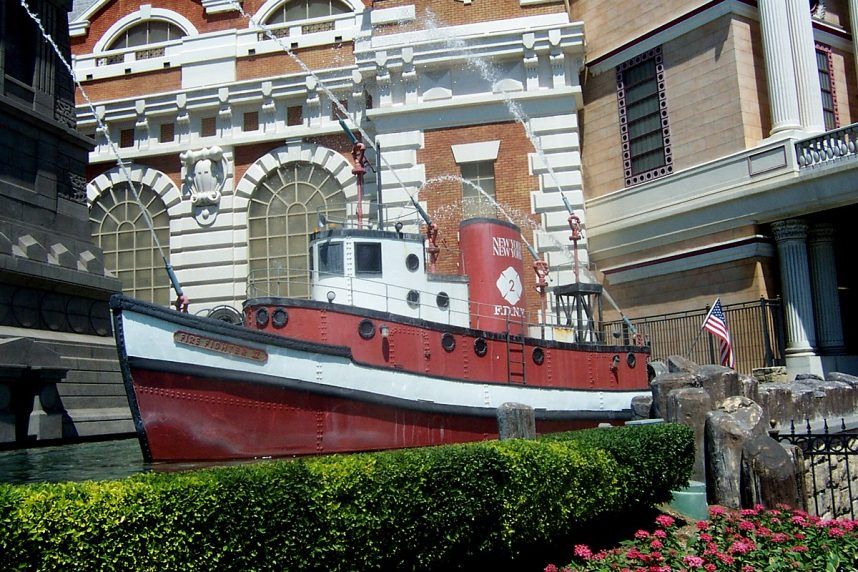
But the loss of some more subtle design details — ones that once helped define the Strip’s most famous casino resorts — tends to register more with the subconscious. You feel their absence more than see it.
Some of these changes reflect quiet efforts by the resort companies to de-theme themselves from peak Disney in the ‘90s, but not all.
How many of the following things did you notice disappear?
1. New York-New York’s Fireboat
When New York-New York opened in 1997, a faux New York City fireboat shot five arcs of water in the moat at the base of the 47-story faux Empire State Building and the 150-foot faux Statue of Liberty.
A small fountain in disguise, it helped bring the plaster cityscape alive. And following 9/11, it played a pivotal role in the memorial for firefighters that the display became.
Tourists began leaving tributes, particularly around the fireboat. These included over 5,000 T-shirts (many from fire departments and law enforcement agencies across the US.), flags, hats, pins, flowers, and handwritten notes, hung along a wrought-iron fence.
This spontaneous memorial became formalized to some extent by the casino’s owners. In December 2002, MGM Mirage built a glass and granite case near the Statue of Liberty replica to create a rotating display of donated T-shirts, preserving the tributes.
In the spring and summer of 2013, the nautical harbor scene was removed because MGM Mirage executives believed it was dated and, more importantly, it used up valuable frontage that could generate profit for shareholders.
The space is now part of the Hershey’s Chocolate World store entrance, which opened in June 2014 on a widened pedestrian plaza.
2. Luxor’s Luminosity
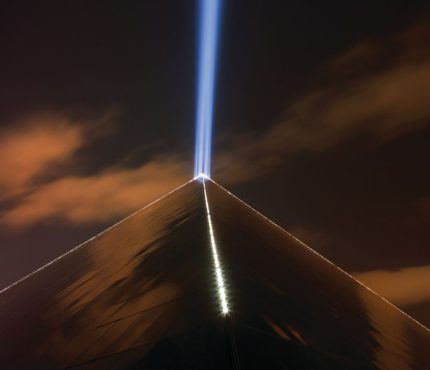
When it opened in 1993, the Luxor light, powered by 39 xenon lights with 7,000-watt bulbs, emitted 42.3 billion candela of light. To put that into perspective, a modern lighthouse emits about 1 million candela. So … 42K lighthouses pointed directly up.
The above paragraph was written in the past tense because the Luxor light has been dimmed by half since 2008. The dimming was implemented by MGM Resorts to save energy and money, and it was hoped that no one would notice.
Except for occasional articles like this that point out the light’s dimming to only the exceptionally bright people who care about such things, it worked. Almost no one noticed. And, even at around 21 billion candela, the ultimate high-beam atop the Luxor is still believed to be the world’s brightest light.
3. Forum Shops’ Dawn-to-Dusk Lighting
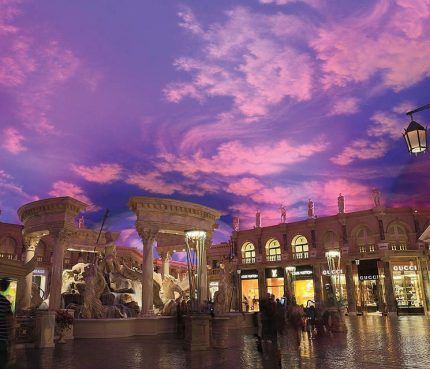
When the Forum Shops opened at Caesars Palace in 1992, you may recall that the sky-painted ceiling over the Forum Shops transitioned from dawn to sunset (but never night) every hour.
The lighting relied on a complex array of color‑changing fixtures and control gears. By the late 2000s, many of the components were obsolete, expensive to replace, and increasingly prone to failure.
Some retail tenants also disliked the darker evening phases, complaining that it made their storefronts less visible and inviting.
But the real reason the effect was scrapped was because it generated no direct revenue. Since around the pandemic shutdown, the poor Forum Shops have been trapped in eternal fake afternoon.
Bonus Forum Shops Detail You Didn’t Notice Go Away: When it opened, the Forum Shops also featured Roman-themed wall reliefs and frescoes in less-trafficked areas. Those have been painted over or replaced with plainer wall treatments during renovations to create a contemporary, less themed aesthetic.
4. Bellagio Conservatory’s Animatronics
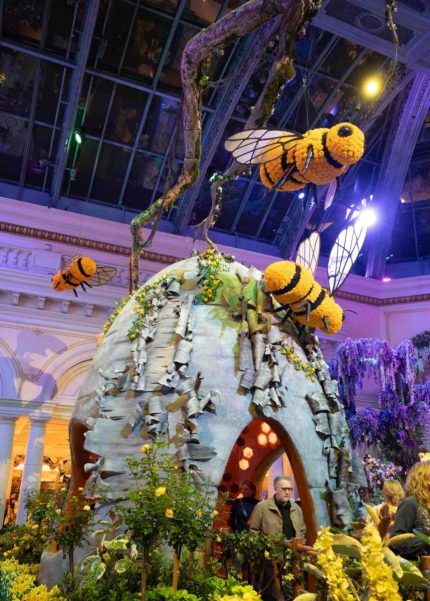
You may also recall how heavily the Bellagio Conservatory once leaned on whimsical animatronics. Blinking owls, flapping butterflies and ladybugs, and nodding penguins once made the colorful floral displays less static.
Those animatronics were custom‑built, often one‑off pieces, and ran for 18+ hours a day in a humid, plant‑filled environment. So motors burned out, linkages loosened, and cosmetic parts faded or warped.
Repairs were expensive and sometimes required the full disassembly of displays, which was also disruptive. And they were too interesting, creating crowd bottlenecks in tight spaces and encouraging taller people to reach out and touch them, risking damage or injury.
Most importantly, though, since the Conservatory is free to visit, every dollar spent on its upkeep comes from the resort’s marketing budget. So, from around 2010-2018, the marketing department gradually cut all the moving parts instead of marketing jobs
5. Public Seating
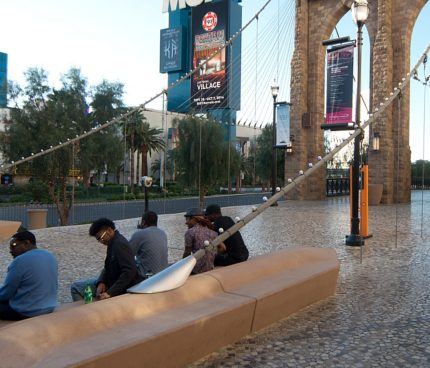
Until the ’90s, hundreds of benches, planter edges, and shaded alcoves provided rest for tuckered and overheated Strip wanderers.
But what shareholder-minded casinos want are people inside their properties spending money, not outside enjoying the scenery. At the same time, most realized they could profit from renting every inch of their outdoor space to high-end outdoor cafés.
Though no one mentions it, the gradual removal of almost all public seating was also undertaken as a measure to reduce sleeping, illegal vending, and panhandling by homeless individuals.
No legal requirement for public seating exists in Clark County, which governs the Las Vegas Strip.
There are still some benches available — notably about a dozen outside the Bellagio fountains, where they face away from the fountains. (This is a standing-room spectacle meant to watch and then quickly move on.)
Today’s Strip is made for walking, not loitering. Pedestrians need to either enter a casino or pay at least $50 a head to eat underneath an umbrella and a mister, to seek relief.
And the Strip feels much less welcoming because of it.
“Lost Vegas” is an occasional Casino.org series spotlighting Las Vegas’ forgotten history. Click here to read other entries in the series. Think you know a good Vegas story lost to history? Email corey@casino.org.
Last Comments ( 4 )
Face it, if there's one change that epitomizes the dunningly bland "new" Vegas, it's the replacement of the Treasure Island pirate show with, cue drum roll, yet another WalCVSgreens. The pirate show (the cute original one with guys not the annoying "siren" females) was corny but charming and actually provided something genuinely fun for tourists on the Strip that no way the "designed in a corporate Boardroom" newer hotels like RW & FB provide. It doesn't surprise me in the least that the masses are losing interest in no-longer fabulous Las Vegas -
I miss the Old Vegas feel. The rough and tumbleness the historic touches gave the place. the Frontier (Old, New) for example. Nods to the miners and the Old West. Now it's all glitz and glamour. I love the "around the world in one place" feel. Venice, Paris, New York, and wish there was more of that. Vegas has had a hard time finding one path to follow and staying on it. Trying to be family friendly just doesn't work. There are Disney resorts and Hershey parks for that. I wish Vegas a long and prosperous life because there is no place like it.
I remember when Paris opened, the overhead music in the bathrooms were french lessons. Long gone.
The list can go on and on... one I remember (and have a photo with) is the frontage at Paris Las Vegas. Used to have a nice facade and include fountains... but like everything else, they chose to transform the space into something that makes a profit over something that provides the guests with an experience.